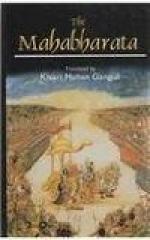71. Thou art the adi of the ganas. By ganas is meant ganayante sankhyayante iti ganah, i.e., tattwah.
72. The commentator explains this by saying that thou art the heavenly felicity which creatures earn by means of their righteous acts. Acts, again, are performed in course of Time whose divisions are caused by the Sun.
73. It has been explained in previous Sections that by success in Yoga one may make oneself as subtile as possible or as gross as possible. One may also attain to the fruition of all desires, extending to the very creation of worlds upon worlds peopled with all kinds of creatures. That Yogins do not create is due to their respect for the Grandsire and their wish not to disturb the ordinary course of things.
74. Satyasandhah is the Bengal reading. The Bombay reading is satrasatwah, meaning, as the commentator explains, satya-sankalpah.
75. Vigraham is explained by the commentator as visishthanubhanbhava-rupam or nishkalam jnaptimatram.
76. In verse 369 ante Upamanyu says that Krishna is to receive from Mahadeva sixteen and eight boons. The commentator, stretching the words has tried to explain them as signifying a total of eight, and eight i.e., eight are to be obtained from Mahadeva, and eight from his divine spouse Uma. The language, however, is such that this meaning cannot be put upon it without doing violence to it.
77. The commentator explains this as ’thou art the cleanser of all cleansing entities, i.e., it is in consequence of thee, Ganga and the others have received the power of cleansing other things and creatures.
78. Adhyatma: that occupies the inner body. Adhibhuta: elements., prima, eyes, ears, etc.; Adhidaivata: sun, moon, etc. that control over the bhutas. Adhiloka—one occupying the lokas; Adhivijnana—one occupying the plane of consciousness; Adhiyajna—one conducting the sacrifices residing in the heart of the jivas.
79. i.e., they attain to Emancipation when they behold thee in the firmament of their own hearts, or succeed in identifying their own souls with thee.
80. The guha or cave in which Brahman is concealed is the heart of every living creature.
81. The worlds or regions commonly enumerated are Bhu, Bhuva, Swa, Maha, Jana, Tapa, and Satya. The eight well-known forms of Mahadeva are Water, Fire, Hotri, Sun, Moon, Space, Earth and Wind. In his form of water he is called Bhava; in that of fire, he is called Rudra; in that of Hotri he is called Pasupati; in that of the Sun, he is called Isana, in that of the Moon, he is called Mahadeva; in that of Space, he is called Bhima; in that of Earth, he is called Sarva; and in that of wind, he is called Ugra. Compare the benediction in Kalidasa’s Shakuntalam.
82. The cave in which Mahadeva has been concealed is the cave of the Scriptures: probably, difficult texts.




